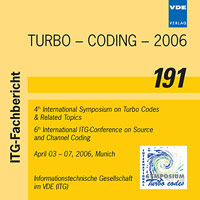Finding Small Stopping Sets in the Tanner Graphs of LDPC Codes
Conference: TURBO - CODING - 2006 - 4th International Symposium on Turbo Codes & Related Topics; 6th International ITG-Conference on Source and Channel Coding
04/03/2006 - 04/07/2006 at Munich, Germany
Proceedings: TURBO - CODING - 2006
Pages: 5Language: englishTyp: PDF
Personal VDE Members are entitled to a 10% discount on this title
Authors:
Richter, Gerd (University of Ulm, Department of TAIT, Albert-Einstein-Allee 43, 89081 Ulm, Germany)
Abstract:
The performance of low-density parity-check (LDPC) codes over the binary erasure channel for a low erasure probability is limited by small stopping sets. The frame error rate over the additive white Gaussian noise (AWGN) channel for a high signal-to-noise ratio is limited by small trapping sets and by the minimum distance of the LDPC code, which is equal to the codeword with the minimal Hamming weight. In this paper, we present a simple and fast algorithm based on the error impulse method to find small stopping sets in the Tanner graphs of LDPC codes. Since a codeword with small Hamming weight can be represented by a special stopping set, the algorithm can also be used to find the minimum distance of LDPC codes. Furthermore, we use the size of the small stopping sets and the minimum distance of the code to calculate asymptotic performance bounds for LDPC codes transmitted over the binary erasure and the AWGN channel, respectively and compare the bounds with simulations.


